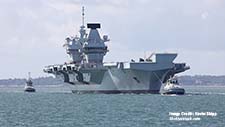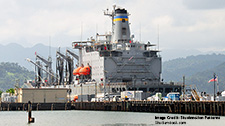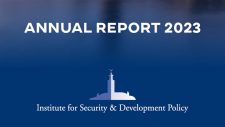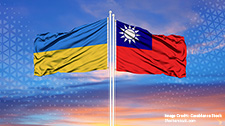Europe’s Pivot to India: Examining India’s NATO Calculus Amid China’s Fall from Grace
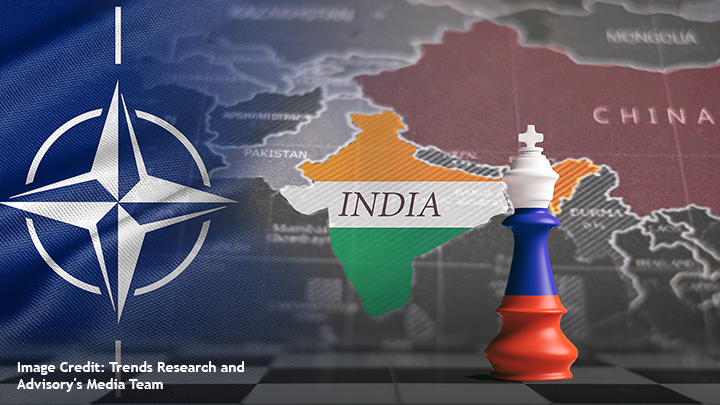
Jagannath P. Panda
India’s so-called “strategic ambivalence” on the war in Ukraine – which is hardly ambivalent and more driven by national interest – is being severely criticized in certain European quarters. A bulk of the criticism is directed at India’s oil trade with Russia: New Delhi has been buying discounted Russian crude oil amid a weakening rupee against the dollar (exports to India increased steeply from about 1 percent to 18 percent during February-May), in order to curb domestic inflation and stave off the negative impact of the sanctions on its Russian tie-ups.[1]
However, the broad contention is that this is just a temporary solution to India’s long-term requirements; more so given the planned European ban on insuring ships carrying Russian oil, which is due to come into effect in December 2022.[2] Besides the short-term economic benefits, Indian energy companies also have stakes in Russian projects that will be impacted by the sanctions regime – hence, the added pressure on India to increase the energy imports.[3] In response to Europe’s criticism, India has called out Western sanctions on Venezuela and Iran for squeezing “every other source of oil”, in addition to the usual railings against Europe’s inability to appreciate the rest of the world’s compulsions.[4]
In contrast, the European Union (EU) has not only identified Ukraine’s security with that of Europe’s, but is also making considerable efforts to reduce its dependency on Russian energy – a “three-pronged plan” of importing more non-Russian gas, shifting into renewable energy, and saving more energy at a cost of about US$316 billion.[5]
For the West, therefore, India is not only at a moral disadvantage but also a less trusted partner for its lack of commitment and political will to stand up to non-democratic means of violence or aggression, especially when they involve utter ruination. This apparent disunity among the democratic world is a bigger concern to some than the ongoing democracies versus autocracies conflict – what some have labeled “the new Cold War”.[6] Such speculations of rift had even foretold an end to the Quadrilateral Security Dialogue (also known as the Quad, comprising Australia, India, Japan, and the US) due to differences with India, but recent summits have reiterated that the partners are united over the core agenda driving the grouping – the Indo-Pacific security architecture where the focus is on China.
Similarly, India-EU cooperation has not as yet been impacted by such dissonance. Although the Western voices that are clamoring for India’s punishment amid its neutral stance seem to be dominating the media, the on-ground reality does not indicate any trend toward even isolation.[7] On the contrary, India is being “courted” by both the East and the West, which is largely a consequence of the events unleashed by the Ukraine war and India’s deft handling of its pointed, multi-alignment foreign policy geared to greater strategic autonomy goals.[8] India’s participation in the Group of Seven (G7) as a partner state, as well as its involvement in BRICS (Brazil, Russia, India, China, and South Africa) and the Russia-India-China meetings, exemplifies India’s unique status today in a divided world.
This is also in line with India’s multipolar world vision, forwarded by Prime Minister Narendra Modi in 2018, of “equitable, pluralistic, and representative” governance.[9] How far this strategy works will also influence the India-China power parity, including India’s much-cherished dream of being a permanent member of the United Nations Security Council.[10] Modi’s repeated presence at the G7 despite differences over Ukraine highlights India’s growing importance in world affairs, and it is not incumbent on just being a counterweight to China.[11]
Further, against a scenario where its Himalayan borders are still in a state of perpetual tensions, Europe’s official recognition of China as a “systemic rival and challenge”, respectively by the EU and the North Atlantic Treaty Organization (NATO), is good news for India. It means that until the Russian antics escalate to a point where India’s present strategy backfires, the focus on China will continue to strengthen India’s position.
But what is the current trajectory of India-EU ties? Would India be receptive to NATO’s outreach in the Indo-Pacific? What are India’s objections to the “Asian NATO” proposition? And will the “China threat” bring NATO and India closer?
India’s post-Ukraine cooperation fillip with the EU
Since the Ukraine War started, India has welcomed a flurry of high-level international visitors, including from Europe (Austria, Lithuania, Luxembourg, Netherlands, Norway, Poland, Portugal, and Slovenia, among others). The primary aim of these visits initially was to convince India to reconsider its stand, but they have given momentum to the already strengthening cooperation, as evidenced by the outcomes from outgoing UK Prime Minister Boris Johnson’s and European Commission President Ursula von der Leyen’s (first visit as EU chief) calls.
With bilateral trade achieving a credible annual growth of about 43 percent in 2021-22 (the EU is also India’s second-largest trading partner, after the US, and destination for Indian exports), Modi and von der Leyen agreed to form an EU-India Trade and Technology Council – the first such deal for India and only second for the EU – to deepen cooperation in trade, technology, and security.[12] Her visit also helped resume the “broad-based, balanced, and comprehensive” Free Trade Agreement (FTA) negotiations, with the first round concluding in July and the second slated for September.[13] The FTA will propel India to expand and diversify its exports, as well as maximize the competitive advantage.[14]
Soon after, Prime Minister Modi’s hectic visit to Europe in May (three countries in three days) in what was his first international trip in 2022, highlighted the importance of Europe in India’s policy today and also helped calm the frayed nerves vis-à-vis its neutral stand.[15] Energy security, secure supply chains, and sustainability (including green energy) are the three top areas of interest for both India and the EU; Modi’s visit emphasized on the three, in addition to showcasing business and investment opportunities in India.
Modi’s participation in the second Nordic Summit was of particular significance amid Finland and Sweden’s NATO accession, which is unlikely to affect India’s burgeoning relations with the Nordic states or the Russian stand. Their joint summit, unlike the stand-alone G7 plus partner countries’ Resilient Democracies Statement, did not ignore the Ukraine crisis but pointed to the “destabilizing” effects. Besides Ukraine, the summit covered a wide range of issues including post-pandemic economic recovery, climate change, innovation and technology, renewable energy, the evolving global security scenario and cooperation in the Arctic – an important avenue given increased Russian-Chinese stakes and the ensuing questions post-sanctions.[16]
Prior to the NATO summit in Madrid, which has exacerbated Europe’s relations with both Russia and China, Modi’s second visit to Europe (for the G7) in a span of days, while steering clear of these tensions, reiterated India’s centrality in transatlantic geopolitics beyond tokenism.[17] His one-on-one meetings with several world leaders are reminiscent of his phone calls soon after the war had begun, underscoring India’s acute and mature diplomatic judgment. The G7+5 joint statement reaffirmed that the West values India’s democratic credentials and its indelible part in maintaining rules-based international order in defiance of China. The G7 statements have been rejected by China, comparing them unfavorably to the “inclusive” BRICS statement and as a means to sow discord among BRICS nations (mainly referring to India).[18]
Accepting their respective positions on Ukraine and choosing to move forward with cooperation in areas of mutual interest have made these achievements possible – many of which are notable firsts. Europe and India’s mutual outreach has promoted dialogue, which has in turn paved the way for the partners to prioritize their relationship and overcome their differences on this polarizing and decade-defining issue of Ukraine. Moreover, the perseverance is a testament to the importance of their strategic partnership for both Europe and India. New Delhi believes Europe will be a strong player in a truly multipolar world and wants it as a key partner. For the EU, India provides an ideal “entry point” for its ambitions in the Indo-Pacific to execute and strengthen its position further in the region.[19]
Moreover, the breakdown of relations between the EU and China has allowed Europe to step up its engagement with India as their security outlooks have grown more similar. While Europe has chosen to be vocal on Russia’s infringements of the international order, in the past it has trodden more carefully with regard to China. Now, however, tensions have come to the surface.[20] Europe has been emboldened by China’s “friendship” with Russia and their concerted and repeated attacks on NATO, blaming the eastward expansion for Europe’s troubles to adopt a more confrontational approach to China.
This has fundamentally shifted the European foreign policy to a direction that is more closely aligned with that of India’s, which is set to be an “accidental beneficiary.”[21] Moreover, despite India’s long-term ties to Russia, strategic calculations in Brussels will likely view these ties as much less of a threat than China’s close relations with Russia. This is due not only to India’s democratic credentials but also to China’s unstoppable rise and growing clout in Central and Eastern Europe and the Arctic – the latter Asian giant has obviously fallen out of favor. Europe also sees an opportunity to increase trading opportunities as Delhi reduces its overdependence on Moscow for defense equipment.[22] Notwithstanding current claims of bonhomie and strong foundation, continuous fortification of commercial and security partnerships that will not waver under the pressure of their underlying differences is necessary.[23]
NATO expansion: Does it matter to India?
At the outset, India-EU ties look positioned to benefit from NATO expansion because of their newly proclaimed common position on China. The recently released NATO Strategic Concept in June 2022 identifies China as a “systemic threat” to North Atlantic security and aims for closer cooperation and possible expansion into Asia to confront the situation. NATO’s re-focus is bringing attention to China, which is set to benefit India as a gateway to the Indo-Pacific for Europe.[24] However, India’s officially recalcitrant stance toward NATO and the general concept of “bloc politics” could be a setback for cooperation, even as certain strategic circles in India are questioning the lack of impetus for a “collective engagement” with NATO given India’s recent proclivity toward security/military exchanges via bilaterals and minilaterals (e.g. Quad).[25] India was noticeably absent as a NATO Asia-Pacific partner at the summit in Madrid, while Australia, New Zealand, Japan, and South Korea were all present to forge stronger security ties. India’s exclusion was not a repercussive move over Delhi’s stance on Ukraine, but rather a choice by New Delhi to stay clear of any involvement: A formal expansion of NATO into Asia or even a NATO-like collective security-oriented alliance remains unacceptable to New Delhi and the enduring principle of non-alignment.[26] Besides, the emergence of an “Asian NATO” is unlikely for the following reasons:[27]
- Asia is a “non-monolithic entity” – political, social and cultural diversity, along with the widely differing interests of states and limited consensus on threat perception makes the notion of a collective security organization difficult.
- As much as China is a primary threat for many regional powers, most do not see it as a permanent enemy in the way Russia is for Europe.
- China is deeply integrated with the region; Beijing’s immense economic and political clout, as well as outreach, will prevent states from entering into a contractual obligation inherent in a NATO-like alliance.
- India’s multipolar vision dissuades the formation of a military alliance – though it is not an inconceivable action in the future.
Notably, New Delhi would reckon the possibility of a military alliance under extreme conditions; the two probable but distant scenarios are China’s attack on India, leading to a full-scale China-India war, or Beijing’s invasion of Taiwan, leading to a range of complex regional security conditions that would affect India’s security primarily on the maritime domain.[28] Under other circumstances, India will continue its ‘power-parity’ calculus vis-à-vis China along with its multifaceted, assertive foreign policy.
Nevertheless, there are doubts as to how realistic it will be for India to continue to maintain this position of strategic autonomy, given that it needs to take effective moves to counter-balance China. Arguably, India is already involved in geopolitical bloc politics, despite its aversion, via its membership to the Quad. Though India’s Minister of Foreign Affairs, S. Jaishankar, continues to argue that the Quad is not “directed against any country” and does not act as an “Asian NATO”, it is undeniably a minilateral that has emerged as a response to China’s assertive behavior; and the primary agenda is to counter Beijing.[29] China certainly believes so, with top foreign ministry officials drawing parallels between NATO’s eastward expansion and bloc politics emerging in the Indo-Pacific.[30] India, however, interprets this as merely evidence of China’s paranoia about the emergence of a Western alliance in the Indo-Pacific, and asserts that the circumstances in Europe and Asia are not similar.
Yet, it is the common threat of a hegemonic China that has brought the US and Europe closer to India, pushing it to effectively discard its non-alignment principles and even conjure a future where “customized” cooperation with the NATO framework is not a pipe-dream.[31] New Delhi will continue to strengthen its ties with the European world, while an effective engagement with NATO remains a lesser subject for now.
Related Publications
-
Needed, a Framework to Protect Undersea Cables
In the data-driven world we live in, submarine cables are the arteries that connect nation-states and their people in literally every human activity, including trade, commerce, entertainment, and social interactions. […]
-
India-Japan-Philippines: A Strategic Maritime Trilateral or More?
Regional states like India, Japan, and the Philippines have been seeking cooperative solutions with other middle powers that can both counter the Chinese influence and fulfill other economic as well […]
-
ISDP Annual Report 2023
ISDP’s Annual Report for the year 2023. We look back on 2023, a year in which tensions and conflicts captured the strategic space in ISDP’s focus areas, making headlines around […]
-
Quad Plus EU: A Viable Option for the Times?
Today, the primary Indo-Pacific contest is not just about the China-US hegemony. It also involves a range of so-called “middle powers” – including Australia, France, Germany, India, Indonesia, Italy, Japan, […]
-
Not Drawing a Parallel. Ukraine and Taiwan: An Indian Perspective
Russia’s war against Ukraine has not only had economic, diplomatic, and geopolitical repercussions, but also exaggerated the fear of accelerated conflicts in the Indo-Pacific, a region with several unresolved conflicts […]
